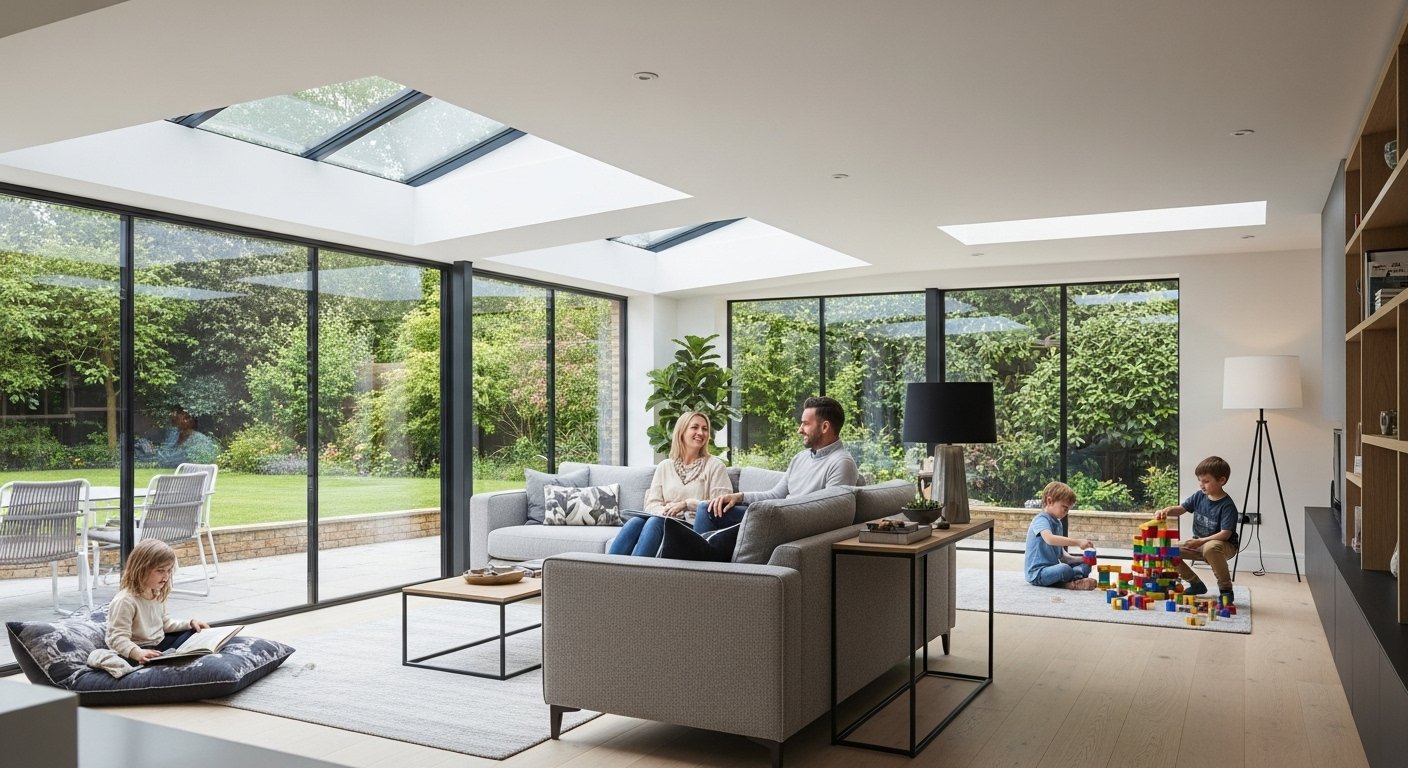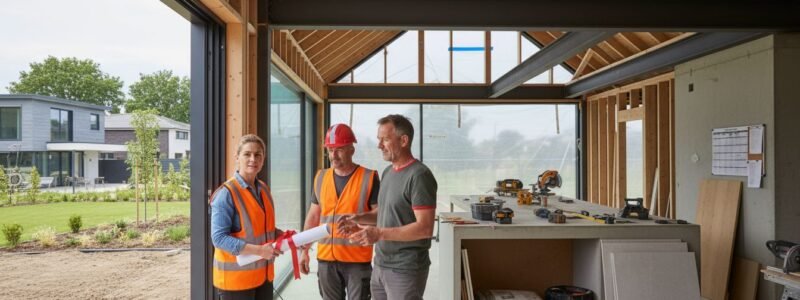Extending your living room can do more than just give you extra square footage. Some UK extensions add as much as 20 percent to overall home value, which is no small jump. Yet fewer homeowners realise that the real magic often lies in clever design choices, not just extra walls and floors. The secret? Sometimes it is innovative use of natural light or multi-functional furniture that completely transforms how your living space feels and works.
Table of Contents
- Assess Your Available Space For Extension
- Choose The Right Type Of Extension
- Embrace Open-Plan Living
- Incorporate Natural Light In Your Design
- Use Multi-Functional Furniture
- Explore Outdoor Living Options
- Consider Planning Permission And Regulations
Quick Summary
| Takeaway | Explanation |
|---|---|
| Assess available space before extending | Measure room dimensions and identify structural constraints for effective planning. |
| Choose an extension type that suits your style | Match extension styles to existing architecture and lifestyle needs for better integration. |
| Integrate natural light into your design | Use large windows and skylights to enhance mood and energy levels in living spaces. |
| Embrace multi-functional furniture solutions | Select adaptable furniture that optimises space and caters to varying family needs. |
| Understand planning permissions and building regulations | Familiarise yourself with legal requirements to ensure your extension project progresses smoothly without issues. |
1: Assess Your Available Space for Extension
Before diving into living room extension ideas, understanding the available space becomes crucial for a successful home renovation project. The first step involves a comprehensive spatial assessment that determines the potential and limitations of your current living environment.
Carefully evaluating your existing living room dimensions provides the foundation for planning an innovative extension. This process requires a systematic approach that considers multiple critical factors. According to the UK Planning Portal, homeowners must thoroughly examine several key aspects:
Physical space measurements: Precisely document your current living room’s length, width, and height
Structural constraints: Identify load-bearing walls, existing architectural features, and potential obstructions
External environment: Assess garden space, proximity to boundaries, and potential impact on outdoor areas
Measuring your available space involves more than simple numerical calculations. Professional assessment helps uncover hidden opportunities and potential challenges. A detailed survey can reveal unexpected possibilities for extending your living area, transforming seemingly limited spaces into functional and aesthetically pleasing environments.
Understanding your property’s specific characteristics is essential. Different homes present unique challenges and opportunities. Period properties might have complex structural considerations, while modern homes could offer more flexible extension potential. Read our comprehensive guide on home extension planning to gain deeper insights into navigating these intricate considerations.
Key considerations during space assessment include legal permissions, building regulations, and potential impact on natural light and existing room configurations. Homeowners must balance their creative vision with practical limitations, ensuring that the proposed extension enhances rather than compromises the overall living space functionality.
2: Choose the Right Type of Extension
Selecting the appropriate extension type represents a critical decision that significantly impacts your living room’s functionality, aesthetic appeal, and overall home value. Different extension styles offer unique advantages and transform spaces in remarkably distinct ways.
According to Torbay Council’s House Extension Design Guide, extensions must harmonise with the original dwelling’s architectural character while meeting your specific spatial requirements.
Key extension types for living rooms include:
Rear Extension: Provides seamless additional space at the back of your property
Side Return Extension: Utilises narrow side spaces for width expansion
Wraparound Extension: Combines rear and side extensions for maximum flexibility
Single Storey Extension: Adds ground floor space without vertical complexity
Double Storey Extension: Maximises spatial potential by adding multiple levels
Each extension type presents unique structural and design considerations. Rear extensions typically offer straightforward integration with existing living spaces, while side return extensions can transform narrow, underutilised areas into functional living zones. Wraparound extensions provide the most comprehensive spatial transformation, allowing significant redesign potential.
Explore our guide on creating smart home extensions to understand how different extension styles can solve your specific space challenges. Consider factors like natural light, room flow, external architectural coherence, and your specific lifestyle needs when making this crucial selection.
Professional consultation becomes invaluable during this decision making process. Experienced architects can help you navigate complex planning regulations, structural limitations, and design opportunities, ensuring your chosen extension type perfectly matches your vision and practical requirements.
3: Embrace Open-Plan Living
Open-plan living represents a transformative approach to home design, breaking down traditional spatial barriers and creating fluid, interconnected living environments. This contemporary style allows seamless interaction between different functional zones, promoting a sense of spaciousness and enhanced social connectivity.
According to research from the University of Liverpool, designing open-plan spaces requires careful consideration of acoustic comfort and individual noise sensitivity. The goal is to create a harmonious environment that balances social interaction with personal comfort.
Key benefits of open-plan living include:
Enhanced Social Interaction: Facilitates easier communication between family members
Improved Natural Light: Allows light to flow more freely across connected spaces
Flexible Space Utilisation: Enables dynamic reconfiguration of living areas
Increased Property Value: Modern buyers often prefer versatile, interconnected living spaces
Successful open-plan living requires strategic design considerations. Zoning becomes crucial in preventing the space from feeling overwhelming or disjointed. Techniques like varied floor levels, subtle colour transitions, and strategic furniture placement can help define distinct functional areas without erecting physical barriers.
Learn more about open-plan extension concepts to understand how this design approach can revolutionise your living environment. The key is creating a balanced space that feels simultaneously open and intimate, allowing different activities to coexist harmoniously.
Consider integrating multifunctional furniture and flexible design elements that can adapt to changing family needs. Hidden storage solutions, movable partitions, and smart lighting can help maintain the open feel while providing practical functionality for modern living.
4: Incorporate Natural Light in Your Design
Natural light transforms living spaces from mere functional areas to vibrant, energising environments. Strategically designing your living room extension to maximise daylight can dramatically enhance both aesthetic appeal and psychological wellbeing.
According to the Town and Country Planning Association, natural light plays a critical role in maintaining human health, happiness, and safety within living spaces. Thoughtful architectural design can significantly improve how light flows through your home.
Key strategies for maximising natural illumination include:
Expansive Glass Surfaces: Large windows and sliding doors that create seamless indoor-outdoor connections
Skylights and Roof Lanterns: Introducing overhead light sources that flood spaces with sunshine
Reflective Surfaces: Using light-coloured walls and strategic mirror placement to amplify existing light
Minimalist Window Treatments: Choosing sheer or translucent coverings that permit maximum light penetration
The orientation of your extension significantly influences natural light potential. South-facing extensions typically receive the most consistent daylight, while carefully positioned windows can capture morning or afternoon sun depending on your preferences.
Explore modern extension design techniques to understand how contemporary architectural approaches can revolutionise your living space’s illumination. Consider incorporating glass walls, light wells, or clerestory windows to create a bright, inviting atmosphere.
Remember that natural light is more than aesthetic. It impacts mood, productivity, and overall well-being. By prioritising light in your extension design, you are not just creating a space but crafting an environment that nurtures and energises its inhabitants.
5: Use Multi-Functional Furniture
Multi-functional furniture represents a revolutionary approach to modern living, enabling homeowners to maximise space efficiency while maintaining aesthetic flexibility. These intelligent design solutions transform living room extensions into adaptable, dynamic environments that respond seamlessly to changing lifestyle needs.
According to research from Heriot-Watt University, innovative furniture design can significantly enhance living space functionality by integrating smart technologies and versatile features.
Essential multi-functional furniture strategies include:
Convertible Seating: Sofas that transform into beds or feature hidden storage compartments
Extendable Tables: Dining surfaces that adapt to different group sizes
Modular Shelving: Flexible units that can be reconfigured based on current requirements
Nested Furniture: Compact designs that stack or fold when not in use
Designing with multi-functional furniture requires strategic thinking. Prioritise pieces that offer genuine versatility rather than complicated mechanisms that compromise comfort. Look for clean, streamlined designs that integrate smoothly with your living room’s overall aesthetic.
Discover smart home extension solutions that demonstrate how intelligent furniture selection can transform living spaces. Consider pieces that serve multiple purposes: a coffee table with built-in charging stations, ottomans with internal storage, or wall beds that disappear when not in use.
The ultimate goal of multi-functional furniture is creating spaces that feel simultaneously spacious, organised, and adaptable. By selecting pieces that work harder and smarter, you can design a living room extension that grows and changes with your family’s evolving needs.
6: Explore Outdoor Living Options
Outdoor living spaces represent an innovative extension strategy that blurs the boundary between interior comfort and exterior beauty. By thoughtfully designing transitions between indoor and outdoor areas, homeowners can create versatile environments that expand functional living space and enhance overall property value.
According to Camden Council’s planning guidelines, carefully considering extension designs that incorporate outdoor elements requires understanding specific regulatory requirements and potential permission constraints.
Key considerations for integrating outdoor living options include:
Sliding Glass Doors: Create seamless indoor-outdoor connections
Covered Patio Areas: Provide sheltered external living spaces
Integrated Decking: Extend usable floor space beyond traditional interior boundaries
Bi-fold Window Systems: Enable complete visual and physical integration with external environments
Architectural continuity becomes crucial when designing outdoor living spaces. Materials, colour palettes, and design elements should create a harmonious transition that feels like a natural extension of your interior living room. Consider using similar flooring materials, consistent colour schemes, and matching architectural details to create a cohesive aesthetic.
Explore our comprehensive guide to rear extensions to understand how outdoor living options can transform your home’s functionality. Strategically designed outdoor spaces can serve multiple purposes: entertaining areas, relaxation zones, dining spaces, or even outdoor workspaces.
Additionally, outdoor living options provide significant psychological benefits. Access to natural environments reduces stress, improves mental wellbeing, and creates opportunities for family connection. By treating outdoor spaces as legitimate living areas, you expand your home’s potential beyond traditional interior boundaries.
7: Consider Planning Permission and Regulations
Navigating planning permissions represents a critical step in transforming your living room extension vision into reality. Understanding the complex landscape of legal requirements ensures your project progresses smoothly without unexpected regulatory obstacles.
According to UK government guidance, homeowners must carefully evaluate whether their proposed extension falls within permitted development rights or requires formal planning approval.
Key regulatory considerations include:
Size Limitations: Restrictions on extension dimensions relative to original property
Location Restrictions: Rules governing proximity to property boundaries
Design Requirements: Aesthetic and structural compliance with local planning guidelines
Conservation Area Constraints: Special regulations for properties in heritage zones
Most residential extensions benefit from permitted development rights, which allow moderate improvements without full planning permission. However, these rights come with specific conditions that demand meticulous attention to detail.
Learn about the comprehensive house extension approval process to ensure your project meets all necessary legal requirements. Professional consultation can help decode complex regulatory frameworks and prevent potential future complications.
Beyond planning permissions, building regulations approval remains equally crucial. These regulations ensure your extension meets essential safety, energy efficiency, and structural integrity standards. Working with experienced professionals who understand local council requirements can streamline this complex process, transforming potential bureaucratic challenges into a smooth, well-executed home improvement journey.
Transform Your Living Room Vision Into Stunning Reality
Feeling limited by cramped space, dated layouts or a lack of natural light in your living room? The article highlights how thoughtful extension design can solve these problems, from smart open-plan layouts to multi-functional furniture and seamless indoor-outdoor zones. But without expert planning and execution, turning big ideas into real living space can feel overwhelming. Achieving a modern, functional extension that matches your home and lifestyle requires not only creativity but also in-depth knowledge of permissions, structural challenges and the right support.
Explore more inspiration and see real solutions to common living room dilemmas. Visit our Extension Inspiration & Ideas for Your Home collection for even more possibilities. Ready to create a bright, open and truly tailored living room extension? Our experienced team manages every detail of the design and build process for London and Surrey homeowners. Make your next move count. Start your transformation today by reaching out at Contact Us.
The table below provides a comprehensive summary of the seven innovative living room extension ideas discussed in the article, outlining the key focus, benefits, and considerations of each approach.
| Extension Idea | Key Focus | Main Benefits | Important Considerations |
|---|---|---|---|
| Assess Your Available Space | Evaluate room dimensions and structural features | Enables optimal planning and tailored solutions | Carefully consider legal, structural, and environmental factors |
| Choose the Right Type of Extension | Select the most suitable extension style for your home and needs | Seamless integration, increased space, boosted property value | Match design to existing architecture; seek professional guidance |
| Embrace Open-Plan Living | Create fluid, interconnected spaces with minimal barriers | Enhanced social interaction, improved light, modern appeal | Use strategic zoning and furniture placement for comfort and function |
| Incorporate Natural Light in Your Design | Maximise daylight with glass, skylights, and reflective décor | Brightens space, lifts mood, supports wellbeing | Consider extension orientation and window treatments |
| Use Multi-Functional Furniture | Select adaptable, space-saving pieces | Optimises space, increases flexibility, supports changing needs | Prioritise comfort and simplicity in design choices |
| Explore Outdoor Living Options | Blur the boundary between indoors and outdoors with clever design | Extends usable area, improves lifestyle, raises home value | Ensure design continuity and comply with outdoor planning rules |
| Consider Planning Permission and Regulations | Navigate legal processes and building standards | Streamlines project, avoids costly delays, ensures compliance | Carefully check permitted development status and local requirements |
Frequently Asked Questions
How do I assess the available space for a living room extension?
To assess your available space, measure the length, width, and height of your current living room and identify any structural constraints, load-bearing walls, and the impact on outdoor areas. A professional assessment can also uncover hidden opportunities for extension.
What types of living room extensions are available?
Common types of living room extensions include rear extensions, side return extensions, wraparound extensions, single storey extensions, and double storey extensions. Each type has unique benefits that can enhance functionality and aesthetic appeal.
What are the benefits of open-plan living in a living room extension?
Open-plan living fosters enhanced social interaction, improves natural light flow, provides flexible space utilisation, and can increase property value by appealing to modern buyers.
How can I maximise natural light in my living room extension?
Maximise natural light through strategies such as using expansive glass surfaces, incorporating skylights, employing light-coloured reflective surfaces, and opting for minimalist window treatments that allow maximum light penetration.





